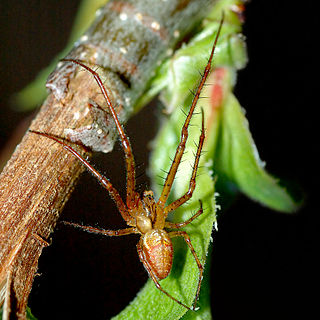
The genus Argiope includes rather large spiders that often have a strikingly coloured abdomen. These spiders are distributed throughout the world. Most countries in tropical or temperate climates host one or more species that are similar in appearance. The etymology of Argiope is from a Latin word argentum meaning silver. The carapace of Argiope species is typically covered in silvery hairs.

Long-jawed orb weavers or long jawed spiders (Tetragnathidae) is a family of araneomorph spiders first described by Anton Menge in 1866. They have elongated bodies, legs, and chelicerae, and build small orb webs with an open hub with few, wide-set radii and spirals with no signal line or retreat. Some species are often found in long vegetation near water.

Pancorius is a genus of Asian jumping spiders that was first described by Eugène Louis Simon in 1902. They are similar to Hyllus.

Atypus, also called purseweb spiders, is a genus of atypical tarantulas first described by Pierre André Latreille in 1804. It occurs in Eurasia, with one species reaching into North Africa, and one species in the USA. Only three of the described species occur in Europe: A. piceus, A. affinis, and A. muralis.

Meta is a genus of long-jawed orb-weavers that was first described by Ludwig Carl Christian Koch in 1836. They are often associated with caves, caverns, and recesses, earning some of them the name "cave orbweavers"

Macrothele is a genus of mygalomorph spiders in the Macrothelidae family, and was first described by A. Ausserer in 1871. It is the only genus in the family Macrothelidae, and most species occur in Asia, from India to Japan, and Java, with four found in Africa, and two in Europe. The name is derived from Ancient Greek μακρός ("makro-"), meaning "big", and θηλή ("thele"), referring to the spinnerets.
Sinocyclocheilus is a genus of freshwater fish in the family Cyprinidae endemic to China, where only found in Guangxi, Guizhou and Yunnan. Almost all of its species live in or around caves and most of these have adaptions typical of cavefish such as a lack of scales, lack of pigmentation and reduced eyes. Several species have an unusual hunchbacked appearance and some of the cave-dwellers have a "horn" on the back, the function of which is unclear. In contrast, the Sinocyclocheilus species that live aboveground, as well as a few found underground, show no clear cavefish adaptions. They are relatively small fish reaching up to 23 cm (9.1 in) in length. The individual species have small ranges and populations, leading to the status of most of the evaluated species as threatened. Many species populations in the genus have yet to be evaluated by the IUCN.

Triplophysa is a genus of fish in the family Nemacheilidae found mainly in and around the Qinghai-Tibet Plateau in China. Currently, the genus is a mixed assemblage of species. Some lineages have been identified and treated as subgenera, but as Wikipedia follows Fishbase for fish species these have been treated as subgenera in Wikipedia, although Kottelat and the Catalog of Fishes treat them as genera. FishBase, however, includes these in Triplophysa without specifying subgenera and treats the names given by Kottelat as synonyms.

Pachygnatha is a genus of long-jawed orb-weavers that was first described by Carl Jakob Sundevall in 1823.
Pinkfloydia is a genus of small Australian long-jawed orb-weavers, reaching a maximum lengths of about 4.5 millimetres (0.18 in). It was first described by D. Dimitrov & G. Hormiga in 2011, and contains two species, found in New South Wales and Western Australia: P. harveyi and P. rixi. They have a unique rounded, cone-shaped head structure with one pair of large eyes and three pairs of smaller eyes. The genus is named after British rock band Pink Floyd.

Allagelena is a genus of Asian funnel weavers first described by Z. S. Zhang, Ming-Sheng Zhu & D. X. Song in 2006.
Dianleucauge is a monotypic genus of Chinese long-jawed orb-weavers containing the single species, Dianleucauge deelemanae. It was first described by D. X. Song & M. S. Zhu in 1994, and is found in China.
Diphya is a genus of long-jawed orb-weavers that was first described by H. Nicolet in 1849. D. tanasevitchi and D. albulum were transferred from Lophomma in 2007.
Guizygiella is a genus of Asian long-jawed orb-weavers that was first described by M. S. Zhu, J. P. Kim & D. X. Song in 1997.
Okileucauge is a genus of East Asian long-jawed orb-weavers that was first described by A. Tanikawa in 2001.
Orsinome is a genus of long-jawed orb-weavers that was first described by Tamerlan Thorell in 1890. It is included in the Nanometa clade, defined by nine morphological synapomorphies, along with Eryciniolia and Nanometa.
Wolongia is a genus of spiders in the Tetragnathidae family. It was first described in 1997 by Zhu, Kim & Song. As of 2017, it contains 10 species, all from China.
Hongkongia is a genus of Asian ground spiders that was first described by D. X. Song & Ming-Sheng Zhu in 1998.
Qianlingula is a genus of Chinese nursery web spiders that was first described by J. X. Zhang, M. S. Zhu & D. X. Song in 2004. As of June 2019 it contains only three species, found only in China: Q. bilamellata, Q. jiafu, and Q. turbinata.
Ge Lin Chu is a Chinese botanist.








